

Eight other satellites that have provided oceanographic data are Seasat, TOPEX-Poseidon, QuickScat, CZCS, SeaWiFS, MOS, ERS-1 and ADEOS. The first three are radar-based observers. Each of the eight provides important information on various aspects of sea state conditions including wind direction and velocity which helped to forecast wave conditions. The most advanced of these was ADEOS, a Japanese-directed satellite that had many sensors; unfortunately, a malfunction put it out of commission after only two months.
Temperature variations are major factors in the development, strength, and directional behavior of moving atmospheric gases (winds). Their prevailing motions change over time, but tend to follow certain preferred paths in various parts of the world. Wind directions are determined indirectly by relating them to the patterns of waves they produce, especially in the open seas. Data from the scatterometer on Seasat helped to generalize wind patterns over the Pacific Ocean, shown in this image:
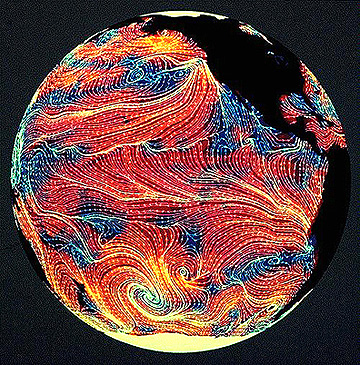
14-29: Why do we want to know about wind patterns? ANSWER
Seasat was the first U.S. satellite that, as an original intention, had as its primary mission the monitoring of oceanic surface phenomena, such as sea state (surface wave parameters, including wavelength, period, and height), surface wind fields, internal waves, currents and eddies, and sea ice characteristics. The radar system on Seasat was described on page 8-6. Radar images from Seasat over land surfaces proved so invaluable that the impression may be that the marine applications were subordinated. Nevertheless, the system performed well over water as intended and scientists gleaned much information about the oceans during its 98 days of service in 1978, before an electrical short circuit disabled it.
Operating at a high depression angle (67 to 73°) to optimize wave detection, the L-band radar on Seasat (with its 25-m resolution) provided some exceptional images of ocean waves. Here is an enlarged image of the North Sea to illustrate this (the image requires careful inspection to see the faint but widespread wave crests):
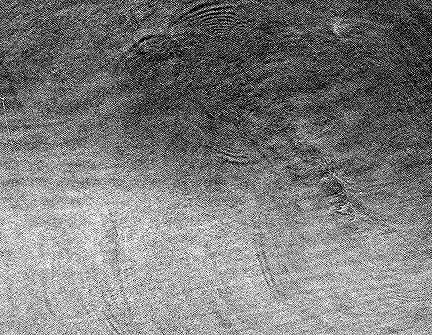
14-30: How many directions of advancing waves can you detect in the above image? ANSWER
Intersecting waves are strongly expressed in this Terra ASTER (sensor) image of waters in the Bay of Bengal east of India. Waves interact with adjacent incoming waves and with land runoff as shown in this ERS-1 radar image taken off the Pacific coast near Los Angeles:

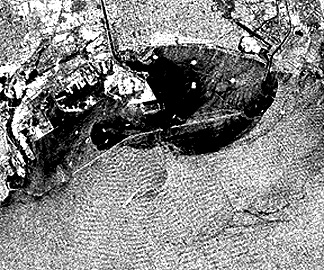
Sometimes conditions are favorable for showing prominent waves and their interactions. A reprocessed astronaut photo taken from the International Space Station contains several sets of conflicting waves and an oceanic stream current passing through them off land in the Gulf of California:
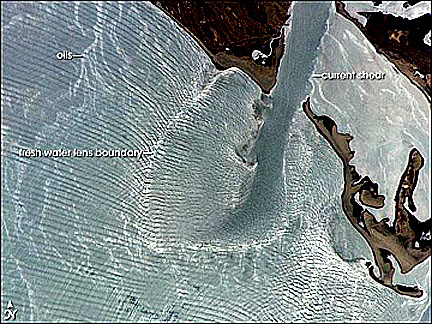
Many wave sets have wavelengths and amplitudes that are small compared to those in the open oceans, in part because of limited fetch (area over which the waves are generated by winds). These require high resolution imagery to detect. Here is a 4-meter resolution IKONOS blue band image of a lake in Mississippi in which the wave train has a northeast directionality:

Surface wave expressions related to variations in bathymetric depths are evident in this Seasat radar image (north to upper left), showing the Nantucket Shoals off Rhode Island. Nantucket Island is at the bottom left.
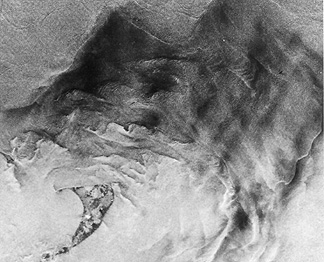
Internal waves, such as those shown in the Sulu Sea (Pacific Ocean), result when a subsurface layer of water with different density and temperature is moved by currents against the upper layer. No surface crests are formed but the motion produces an interference effect visible as dark bands.
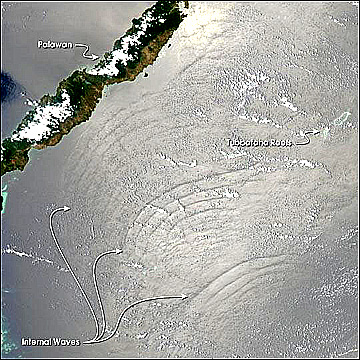
Internal (subsurface) waves in shallow waters in the Gulf of California appear in the next Seasat image on the left (north is towards the lower right).
An interesting phenomenon known as "wake effect" is evident in this SeaWiFS (see next page) image of the Windward Islands in the eastern Caribbean. Prevailing winds from the east encounter topographic highs (mostly volcanic peaks) and are disrupted and slowed down. This leaves calmer surface winds, and much reduced wave heights, on the leeward side. Sun glint helps to emphasize the contrast. We first described the TOPEX-Poseidon (T/P) mission, run by JPL, in page 8-7. We suggest you access this (outstanding tutorial) prepared by the TOPEX-Poseidon team, which explores the kinds of information that radar altimetry and scatterometry can acquire. Here is a sketch of T/P's instruments: 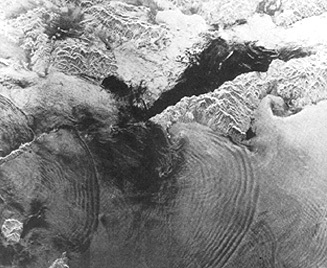
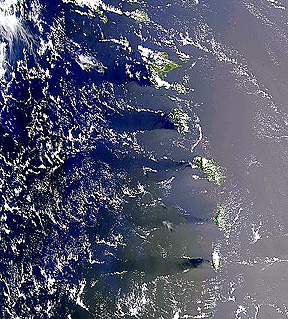

TOPEX-Poseidon uses two radar altimeters to measure distance from the satellite to the sea's surface (to a precision of 4.3 cm). From such data, global maps are derived to show Dynamic Ocean Topography (rises ["hills"] and depressions ["valleys"]), Sea Surface Variability, Wave Heights, and Wind Speeds. A separate microwave radiometer on this mission determines Precipitable Water Vapor, which allows for corrections in the pulse transit time to improve distance accuracy.
14-31: How would T/P determine wind speeds from the observables? ANSWER
The first TOPEX-Poseidon maps we examine show ocean topographic variations. Below is a plot of large-scale variations during September 1992 in ocean elevations relative to the Earth's geoid. The data used to construct the map come from other sources, such as gravitational perturbations of satellite orbits. Note that as much as 150 m (492 ft) of relief exist on the seas between the Atlantic Ocean (lower, green) and the western Pacific (higher, orange-red).
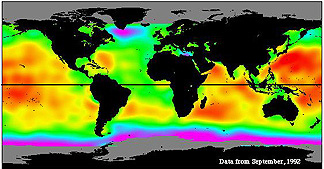
14-32: Where are the oceans the highest? ANSWER
Seasonal differences do occur because of departures from the norms in height, as water expands or contracts in each hemisphere. The pair of maps below show Sea Surface Height (SSH) variation in the northern Fall (upper) and Spring (lower), in a plot centered on the Pacific Ocean. The differences in elevation lead to redistribution of water through thermally-induced currents.
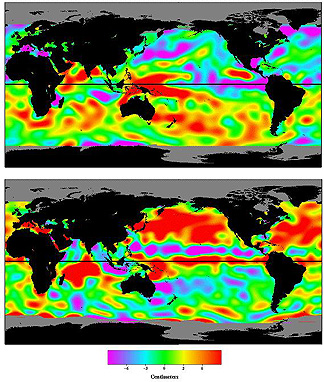
The next pair of maps are plots of wind speeds and wave heights during June 1995. There is some correlation between these parameters: greater speeds tend to cause higher waves.
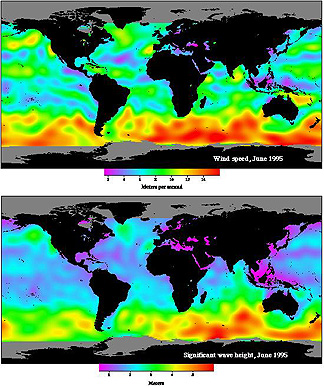
TOPEX-Poseidon also has shed new light on the oceans tides. There has been an ongoing mystery as to balancing the energy provided by the Moon's gravitational attraction, which produces the tides, and the dissipation of that energy. What was known is that much of the energy goes into setting up surficial ocean currents that carry water from higher areas to lower. Ocean heights measurements by T-P have now better fixed the areas of the seas that are higher and lower than mean sea level. This image shows a general pattern:
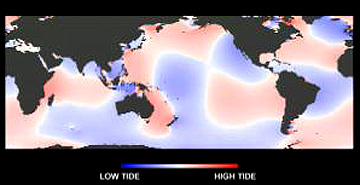
This image shows more details, representing a data sets for six years of observations. The so-called tidal energy dissipation thus displayed is affected in part by variations in sea surface heights which establish gradients that cause water flow that influences tidal rises or falls (see page I-1b.
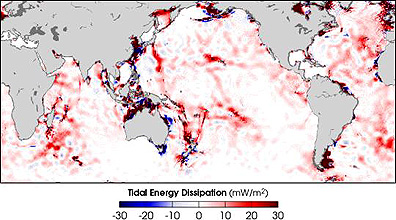
From this can be derived this broad outline of the current flow lines outward from the highs:
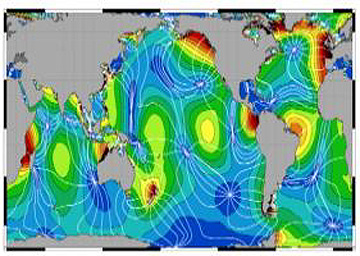
The shortfall of about 30% for the accounting of energy balance in tidal energy distribution has from the T-P observations now been explained by work done in changing ocean volume below the surface. The configuration of the sea floor contributes to this.
One subsurface feature that T-P and subsequent satellites such as Jason and Envisat could detect with their radars is thermally-active whirlpools or mega-eddies (about 100 km wide; several can coalesce) that have maximum spiral circulation at depths below 600-1000 meters (but much less near the surface). The effect diminishes surfaceward but can be identified because surface waters are pushed upwards, so as to have a positive topographic expression. These mega-eddies have 2 to 4 times the salt concentration of normal ocean waters; the resulting increase in density accounts for their activity. Here is an example in the Atlantic (off the Mediterranean Sea where such a feature is commonplace since that Sea has higher average salt concentrations.):
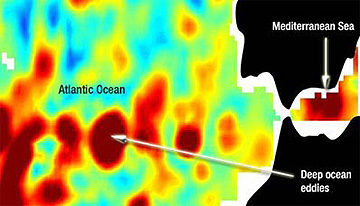
Topex-Poseidon was decommissioned (ceased data gathering) on January 6, 2006.
A follow-up to TOPEX-Poseidon, named JASON-1, is a component of the EOS program (see Section 16). Operated jointly by NASA JPL/CNES, this spacecrafts sensors include C and Ku band radar altimeters, a microwave radiometer, and a Doppler radar. Again, sea surface heights (SSH) are the main oceanographic phenomenon being measured; for Jason, differences in SSH as small as 4.1 cm can be determined.
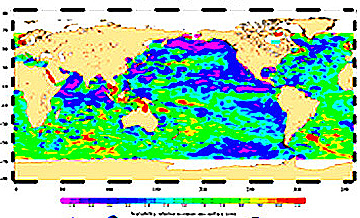
Data from Jason-1 are now being processed routinely by various government and private centers engaged in marine studies. This map of global tropical zones was produced by the Space Center at the Univesity of Texas-Austin.

Just as has been done by Topex-Poseidon for the last 10 years, Jason-1 is gathering daily information on the buildup of hot waters that lead to the El Niño that forms every several years in the Pacific. Here is an October, 2002 Jason-1 map that shows the warming trend in the eastern Pacific - as the winter of 2002-03 ensues, unusual weather has indeed become common in the United States.
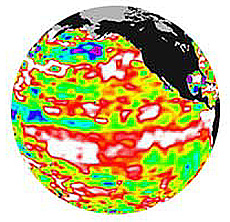
One aspect of oceanographic studies and management that has received considerable attention lately is the state of health of corals - the animals (polyps) that make the foundation of coral reefs which support a wide variety of biota. Various satellites are contributing to an organized monitoring program designed to gather long term data and to "flag" potential local to worldwide conditions that threaten coral populations. Landsat 7 is a mainstay of this effort. Here is a Landsat false color view of part of the Florida Keys (see also page 8-6) which illustrates the monitoring capabilities from satellites.
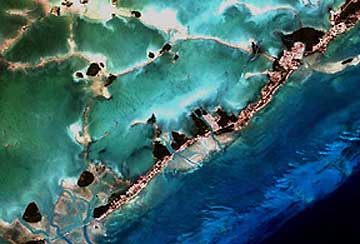
Lidar mounted on aircraft have proved capable of determining the shape, and to some extent, depth of coral reef complexes off island shores. Here is a relief image of Johnson's Reef off St. Johns Island in the American Virgin Islands:
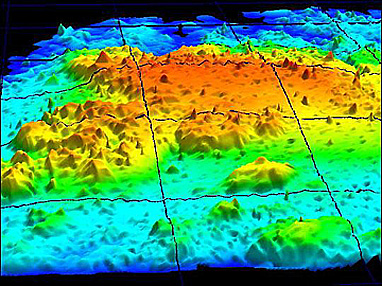
Turning now to the Japanese ADEOS (Midori): ADEOS was launched from Japan on August 16, 1996, and operated successfully for 9 months. The view below shows the sophisticated nature of this satellite:
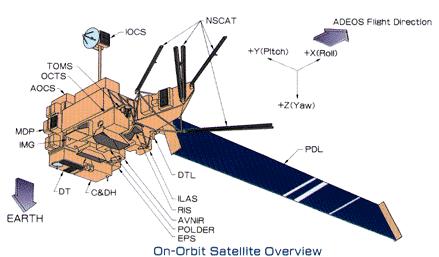
Here is Vis-NIR imager (called AVNIR) image of some of the island reefs in the Great Barrier Reef of northeast Australia.
ADEOS also produced some interesting ocean color images, none more so than this view of the sea around Japan itself, here with the natural colors modified to the full range of blues through reds to emphasize currents and other water circulation patterns: The Jet Propulsion Laboratory (JPL) developed, in cooperation with Japan's NASDA, a follow-on instrument to the Seasat Scatterometer, called NSCAT (NASA Scatterometer) which first flew on ADEOS. NSCAT was a microwave radar scatterometer that transmitted pulses at 13.995 GHz and measured their reflections (backscatter) from ocean ripples and other surfaces. Six antennas provided eight beams that extended over two wide bands. The returned signal is subjected to Doppler processing. In general, rougher seas correlate with greater wind speeds; in turn, rough seas increase backscatter. Operating at 50 km spatial resolution, the system distinguished and recorded 268,000 wind vectors, derived from wave-induced backscatter data. The principal use for NSCAT was in determining wind-direction, from which is derived useful information relative to ocean waves and global climate patterns. The instrument could also operate over land (see page 3-5) and produce sea-ice images (page 14-14). Here is a global, wind-vector map, color coded for grouped intervals of different velocities.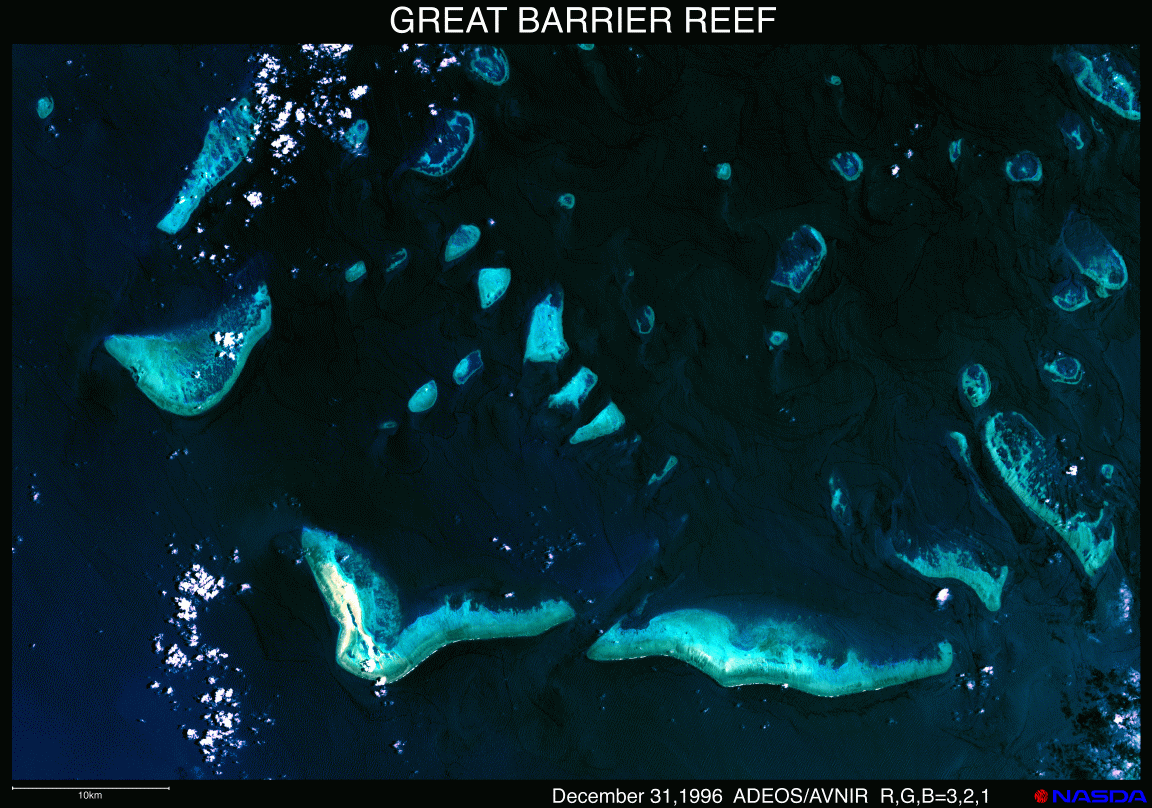
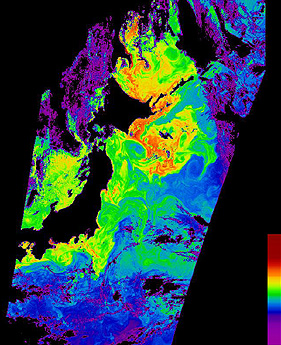
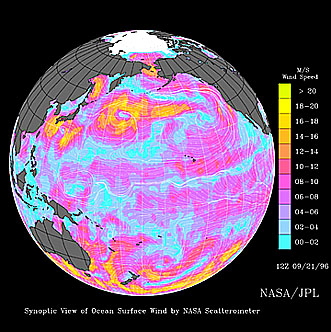
Further processing allows imposition of pseudo-streamlines indicating wind direction, as shown here:

On July 19, 1999 NASA JPL launched QuickScat, a satellite whose prime sensor (SeaWinds) is a radar with 25 meter resolution. Its primary mission is to provide near-realtime measurements of surface roughness that translate into wind velocities.
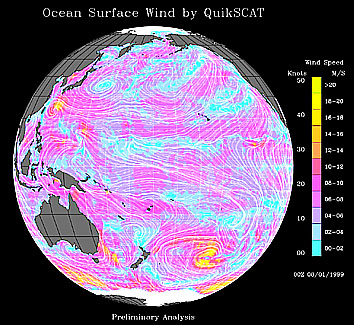
A detailed map of wind speed intervals associated with Typhoon Nesat in the Pacific, on June 6, 2005, shows the details obtainable with the SeaWinds instrument
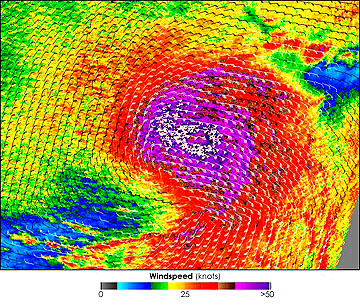

And here is a QuickScat SeaWinds map that includes an actual hurricane, Floyd, a destructive one that hit the southern U.S. in September, 1999; the immediate area of the hurricane appears as an expanded inset:
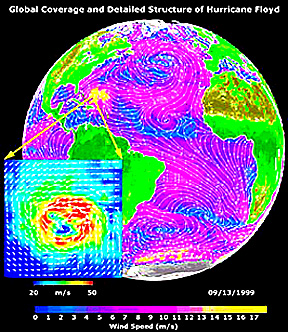
That localized area is shown in more detail in this SeaWinds map of wind flow in the Gulf of Mexico and the Atlantic during Hurricane Floyd on September 16:
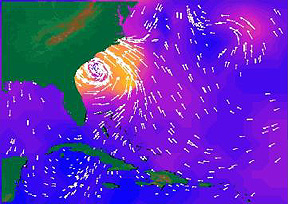
NASA sponsored another SeaWinds radar scatterometer as an instrument package onboard ADEOS-2 (renamed Midori-2) launched on December 14, 2002 by the Japanese NASDA program. Primarily an ocean surface monitor, this sensor can identify sea ice and can, like its predecessors above, determine wind velocities. Here is the first returned data set acquired on January 28-29, 2003:
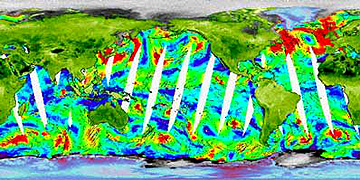
The Japanese have also launched (1987 and 1990) two Marine Observation Satellites (MOS) that include a scanning radiometer (MESSR), a Visible-Thermal instrument (VTIR), and a microwave unit (MSR). These sensors are operated over both land and sea. This MESSR image of the south-central coast of Japan, showing bays below the city of Nagoya, is typical.
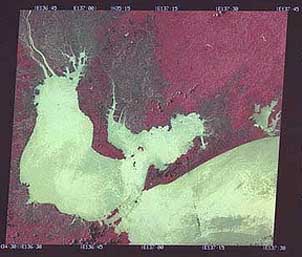
This is a Sea Surface Temperature map of European waters:
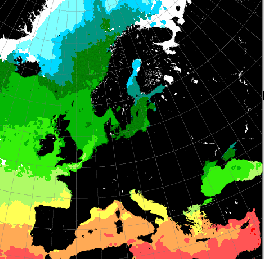

Primary Author: Nicholas M. Short, Sr.